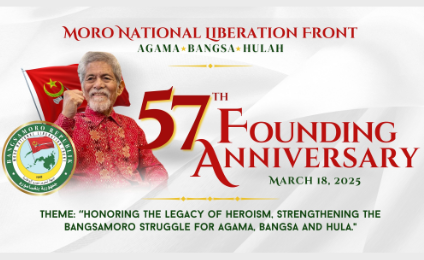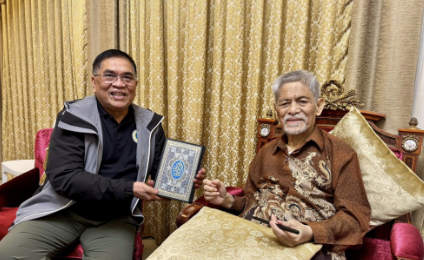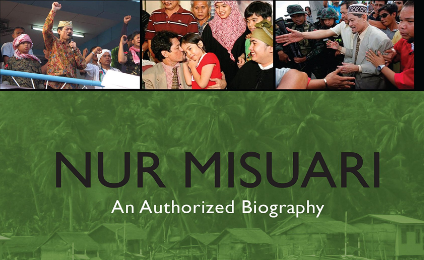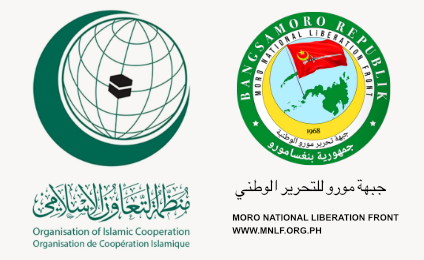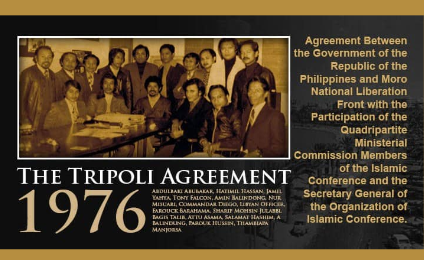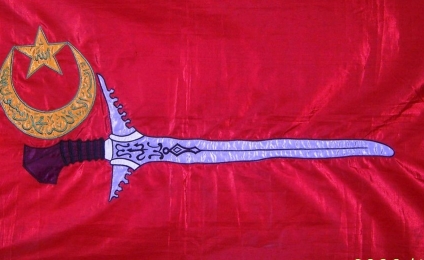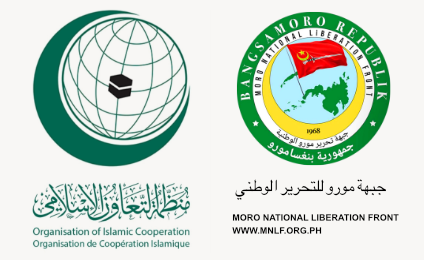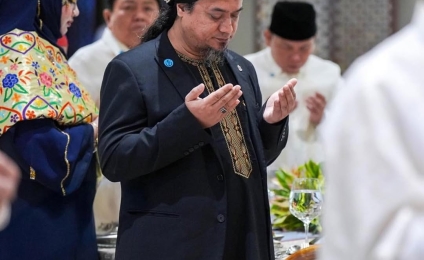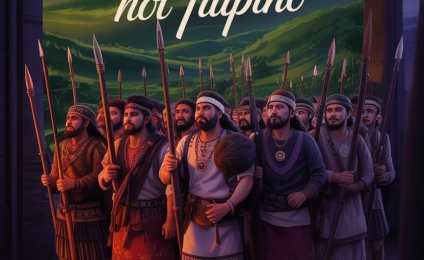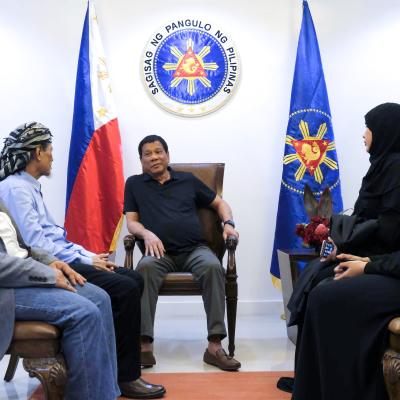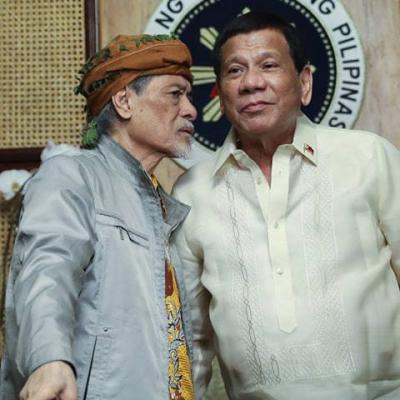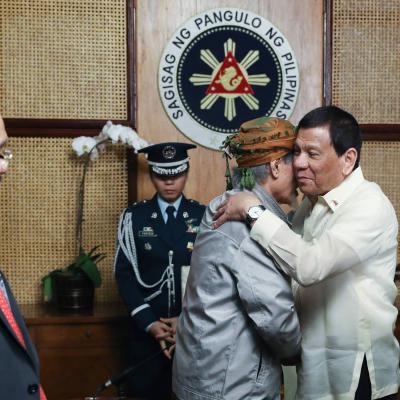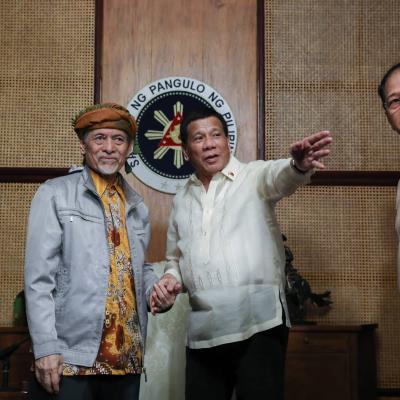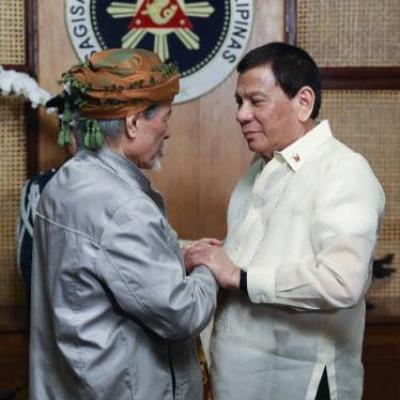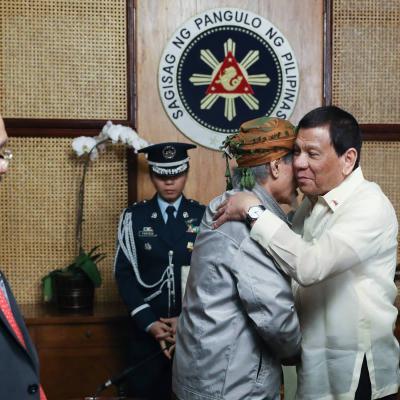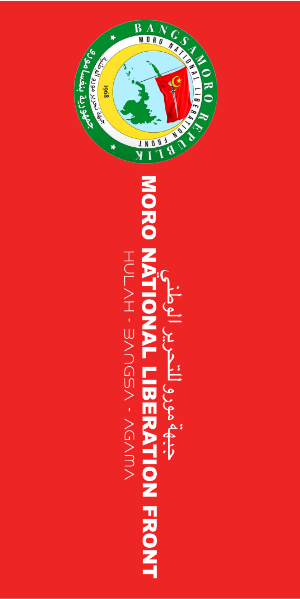It was a cold and dark morning of August 11, 2005 when twelve (12) members of the Mindanao Peaceweavers started its way to Sta. Rosa, Laguna to meet the "Maas".
Tarhata "Tata" Maglangit woke up very early that morning to prepare herself for this long awaited visit. This was the first time she would be meeting the "Maas" in a jail and she doesn't know what to do or expect. It has been four years since the "Maas" had been incarcerated and a lot of things had already happened to the Moro National Liberation Front where Tata has been a loyal member. Watching the gloomy sky, Tata said that the weather seems to be uncooperative with the Peaceweavers. Playing the usual optimist, I told her that the sun will come out soon.
My former MSU Professor Octavio Dinampo explained why his people call MNLF founder and Chairman Nur Misuari "Maas". "Maas" probably means the same in both the Tausug and Cebuano languages, which is "old". But it also connotes a title that befits a holder of wisdom, leadership and statesmanship qualities. People come to the "Maas" for advise,protection probably akin to the concept of "parens patriae" in political law.
It was our second trip to Manila. And second attempt to meet the "Maas". The Mindanao Peaceweavers went to Manila last April to present the results of its Sulu Solidarity Mission to the AFP, key cabinet members and some members of the diplomatic community. Representing civil society in Mindanao, we were concerned over the latest spate of violence in Sulu and the virtual collapse of the 1996 Peace Agreement between the government and the MNLF following an outbreak of battle in Sulu last February.
We were frustrated then because we were not allowed by PNP General Antonio Lomibao to meet Misuari. The reason given was the visit could be a "threat to national security.
After almost four months of persistent follow-up by fellow peaceweaver Atty. Sol Santos, the PNP finally allowed us certifying even in our permit that "all members of the group have derogatory record". "That was such a relief", Fr. Angel Calvo of Zamboanga quipped, who was also a member of the peaceweaver mission.
Our three companions (Prof. Octavio Dinampo, Dr. Sammy Adju and Adzfar Usman) from Sulu brought with them native durians for the "Maas". It was such a torture to smell the aroma of the durian without us actually partaking its incredible taste. The ready supply was for the Maas and sensing our salivating, we were promised our own share anytime we return to visit Sulu. We also brought several books, eggs, and vegetables for Misuari.
Nur Misuari's prison is located at the Fort Sto. Domingo in Sta. Rosa Laguna. His jail is a two-bedroom house which looks like a typical low-cost housing subdivision except that it is locked up with steel bars from the ceiling to the windows and doors. The house is also surrounded with inner and outer barbed wire fences. We learned that it was built for former President Erap Estrada when they needed a place to lock him up after "Edsa 2". He was later transferred to the Veterans Memorial Hospital. In late 2001, Misuari "took over" the prison complex. I remember Misuari telling us that there have already been two Presidents that stayed in Sta. Rosa house. One was the ousted President of the Philippines Joseph Estrada and the second was the "President of the Mindanao Republic"- obviously referring to himself.. We bantered that another President might follow him there.
The night before our visit, we outlined the points to take up with Misuari since our time was limited and knowing also his penchant for lecturing his visitors or audience. We had a four-point agenda in our notes. 1. Update on the Sulu Solidarity Mission 2. Status of the 1996 Final Peace Agreement and the role of OIC and other third party mediators 3. His views on the current political crisis and federalism and 4. the status of his case.
As probably expected in any Misuari conversation, he starts by giving his audience a review of History 101 as a pre-requisite to any discussion of the present situation. With most of us coming from Mindanao, we definitely have heard those lines before -- from the Jabidah massacre, to his UP days as a professor, conversations with the late Senator Ninoy Aquino and of course what Malaysia did to him. At least on my part, I remember having heard him on the same topics at least 3 times in 2000, 2003 and again in this visit.
But that probably reflects the current tug of war between a Mindanaoan settler and an indigenous Moro. A settler usually starts any discussion on the Mindanao conflict with a scan of the current realities emphasizing on where we are now, how can we develop together and then ask what is practical at this point? While the Moro will go back to history, the genocides against them, the injustices and lost territories. And it is capped by a call that any attempt to resolve the conflict now must first rectify the historical wrongs committed against them as a free and distinct people. Unless we have the patience to listen and understand each other's contexts including the seeming historical "fossils" of Misuari, we can never fully comprehend why he says that the Bangsamoro people does not feel welcome by this republic. "We belong to a different culture and civilization and if you want us to feel part of this Republic, you must learn how to respect us", says the "Maas".
Misuari welcomed the Mindanao Peaceweavers telling us that he is very happy to work with our peace initiative. "While the MNLF seems to be embroiled in a kind of political process, what we are fighting is ultimately for the sake of peace. Mindanao is one of the last frontiers in the world left behind in the process of decolonization. The MNLF was formed in 1968 as a result of a kind of situation imposed on us by the Philippine government", Misuari lectures.
In this particular visit, Misuari looked pale and frail. But his voice remain powerful and his eyes still exude the same blazing passion every time he talks about the wars they fought in Mindanao and reminisces the victorious battle in Kabacan which then Gen. Fortunato Abat, in his book, described as the day when the Philippines almost lost Mindanao.
1996 Peace Agreement
"Why do you think they put me here? Do you think the government is sincere in implementing the 1996 Peace Agreement? What is the message of my stay here?"
Misuari explained that some politicians resented being overshadowed by the emergence of the MNLF. And even at that time when he was still ARMM governor, the military did not stop killing MNLF members. They attacked known MNLF camps in open violation of the 1996 Peace Agreement. They colluded to prevent the growth of the MNLF.
Misuari describes the ARMM as a lousy form of autonomy. "I almost died in that situation" was how he described his experience as ARMM governor. He said that government succeeded in sabotaging his administration in the ARMM by not releasing money for their projects.
However, despite the current issues that entangles the Peace Agreement and the hostilities between the AFP and MNLF in Sulu, Nur Misuari claims that he has not abrogated the Agreement. "As Chairman of the MNLF, I cannot do that. What happened in Sulu last February was done by the MNLF in defense of our people. After the
massacre of innocent civilians and helpless children, what did you expect that MNLF will do? We should disband if we cannot defend our people anymore. And that's why the MNLF fought the war in February and it did not stop until more than 300 soldiers were
killed".
Misuari continued that any effort to resuscitate the Peace Agreement should be done under the auspices of the OIC. He stressed there must be a Tripartite Meeting at the highest level composed of the OIC, the Republic of the Philippines and the MNLF. "Government wants to isolate us from our support outside - that we can't accept. I don't want to take the risk negotiating without a third party".
Misuari said that he is willing to review the 1996 Peace Agreement but government must put up with the ground rules first. He wants to see clearly before his eyes what these ground rules are. 'I don't want them to continue fooling and cheating us". When asked about his insights and new paradigms on how we can move further, work together for peace in Mindanao, Misuari told us that he is confused. "I am confused myself. I don't know which direction to take now."
After the meeting with the "Maas", while waiting for our companions from the second batch of visitors, there were informal discussions over this statement from Misuari.
Confused? Fr. Calvo said that Misuari is a charismatic leader. He likes to be with his people and taking him away from them, putting him in this strange place, isolated from his roots with no communication, can certainly weaken him. Human as he is. Anyone can certainly get confused in this situation. Manila-based peaceweaver Lisa Ugay said that she found that statement from Misuari very humbling instead of an admission of weakness.
"I am a man of peace. I am probably the only revolutionary leader in the world who has negotiated with almost all administrations of the Philippine government since the time of Marcos for the sake of peace", I recall Misuari telling us during our first visit to him in 2003.
Federalism
"If we can come up with a good quality of federalism, we can give it a try. But if it is intended to create disunity in Mindanao, I will not support it".
Misuari said he will support federalism for as long as Mindanao remains intact as one state and we federate with Luzon and Visayas. A Mindanao where all the Christians, Muslims and Lumad live in harmony. We can give it a try. By and large we can work together. I can work with Duterte or Pinol in a federal set-up, he said referring to recent snowballing moves for a Mindanao Republic espoused by the two controversial Mindanao local officials.
He recalled that in the 1971 constitutional convention, his number one advocacy was the transformation of our political system to federalism. That was his alternative to the decolonization of Mindanao.
He recalled that in the 1971 constitutional convention, his number one advocacy was the transformation of our political system to federalism. That was his alternative to the decolonization of Mindanao.
Misuari mentioned several attempts for him and the late MILF Chairman Hashim Salamat to settle their differences. They tried but they were not successful. And at this point, he admitted that it's going to be very difficult. Again he expressed concern over the current peace talks with the MILF asking how can the government enter into a peace agreement with the MILF without contemplating giving the same territory given the MNLF in the 1996 Peace Agreement.
Misuari concluded our meeting with this message. " I am for peace. I don't like continuous bloodshed. I don't want my children to say that my father is the cause of all these predicament in Mindanao. I want the economy to grow so that everyone can partake of development but first we must have peace. It must be based on a peace agreement entered into by parties who are honest and sincere".
It was still raining when we left Sta. Rosa. I was wrong. The sun did not come out after all. Each of us were lost with our own thoughts as we negotiated the afternoon traffic into Manila. The word that can probably describe our experience is the one that Misuari had epitomized in his statement "I am confused". We too were confused. But who wouldn't be in the situation we are in now? While we were joking over Misuari's inexhaustible energy to lecture us with history - we realize that perhaps that is the one thing missing in our peace advocacy work. We have to relearn our history to be able to effectively resolve our problems in Mindanao and we must have the patience to listen to each other.
I remember Tarhata telling me that looking at it from another perspective, Misuari is probably luckier to be inside jail compared to the other warring MNLF leaders who are outside and dealing with all the myriad issues from factionalism, the catastrophic state of the 1996 peace agreement and the general dissatisfaction of the MNLF members. Inside the confines of his prison, Misuari finally has the time for himself, for his reflections and to dream on and above all time for Allah. After all, amidst our doubts and confusion, only Allah can give us the answers.
(Mary Ann M. Arnado is the Deputy Director of the Initiatives for International Dialogue, a regional advocacy institution based in Davao City which currently serves as Secretariat of the Mindanao Peaceweavers)
DESPITE THE political crisis hobbling the Arroyo administration today, optimism lives that the country’s most pressing concerns shall continue to receive priority attention from government. Among these priority concerns is the long-drawn out, off-and-on peace negotiations between the Government of the Philippines (GRP) and the Moro Islamic Liberation Front (MILF).
IN HER State of the Nation Address (SONA) last July 25, 2005,President Gloria Macapagal-Arroyo maintained that “80 percent” of the GRP-MILF peace talks “had been completed” and that “permanent peace in Mindanao is within reach.”
THE PRESIDENT’S statement reflected government’s policy framework vis-à-vis securing peace in Mindanao. According to the Medium Term Philippine Development Plan (2001-2004):
“Peace and development cannot be achieved independently. The government is committed to pursue both with equal vigor in order to attain political and socio-economic stability as well as cultural harmony in Mindanao in conformity with the rule of law and in
accordance with constitutional processes. Thus, as government pursues the development of Mindanao, it will also forge peace with the MILF without compromising the country’s national sovereignty while at the same time pursuing its peace agreement with the MNLF.”



 – Awarded for his role in promoting peace and dialogue in the Southern Philippines, particularly in the Mindanao conflict1_small.png)
